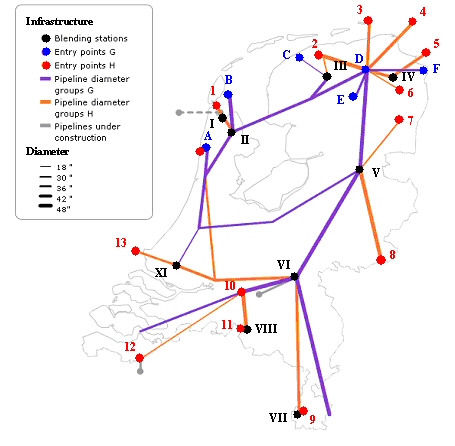Dutch infrastructure
Natural gas is supplied by the producers, via feeding stations to GTS, at a pressure of around 66 bar. Sand, water, condensate and other contaminants are removed from the gas at the wellhead. GTS transports the gas to the gas customers, viz., the Dutch gas supply companies, large industrial consumers, and as export to some European countries (Germany, Belgium, France, Italy, Switzerland and England). The main transmission system comprises approximately 11,000 km of natural gas pipelines at different pressures plus plants and equipment for compressing, blending, metering, and regulating the different gas flows (see figure [1]).
High-pressure Transmission Lines
The High-pressure Transmission Lines (HTL) network has a length of 5,000 km. It carries gas at pressures in the range 43 to 66 bar, and occasionally as high as 80 bar. The gas enters the system at either producer's gas conditioning stations on the gas fields, or at import stations on the border. Nine compressor stations maintain the pipeline pressure at every 80-100 km in the HTL network. It is occasionally necessary to compress gases prior to blending, or to bring them up to transmission pressure. HTL end points are the metering and regulating stations (M&R), which form the link between the HTL and the Regional Transmission Lines (RTL) networks, and the export stations. From M&R stations on no blending facilities are available, therefore the HTL network from metering and regulating point of view seems to be more attractive for SNG injection than the RTL network. From gas trading point of view there’s however also an advantage of injection in the HTL network.
Regional Transmission Lines
The RTL network has a total length of 6,000 km. The operating pressure generally ranges from 16 to 40 bar. The RTL network is supplied from the HTL network via the M&R stations. At M&R stations, the pressure in the HTL system is reduced to an operating pressure of not more than 40 bar. Another function performed at the M&R stations is to give the gas its characteristic smell. Natural gas as it comes out of the ground is virtually odour-free. Odourisation alerts people to leaks. The smell of gas is actually the chemical tetrahydrothiophene (THT). The odourisation process is mainly for the benefit of the domestic consumer. Heavier business and institutional users will often have their own gas detection systems. M&R stations also supply measurement data relating to pressure and flow, which are vital for the control of the gas flows in the network.
Transfer stations
The regional transmission lines carry gas to the transfer stations, which are the feed points for the gas main pipes of the local energy utilities and industries, and the end of the line as far as GTS is concerned. There are a total of about 1,100 transfer stations, with two functions; reducing the pipeline pressure and metering the volume of gas supplied. The gas networks of the gas supply companies operate at pressures of 8 bar or lower. As the pressure drop of over 30 bar (RTL stations), and as much as 60 bar (HTL stations) is accompanied by a substantial drop in temperature the gas is preheated. By the time the gas enters domestic gas pipes, the relative pressure is down to 25 millibar, the standard appliance pressure in the Netherlands.
Export stations
Roughly half of GasTerra sales are destined for export. Like transfer stations, export stations mark the end of the line as far as GTS is concerned. There are 17 export stations, supplying gas to Belgium, France, Germany, Italy, England and Switzerland. Export gas quality ranges from straight Groningen to high calorific value through enriched Groningen gas.
Local gas distribution grid
In contrast with the main transmission system, owned by the Gasunie and operated by GTS, the local network (which was laid to link individual consumers to the main network) is owned mainly by local distribution companies. The local companies acquire the gas on spec through the main transmission system from the gas seller, which is in most cases despite the liberalized market still GasTerra. The grid supervisor DTE regulates both the main transmission system and the local grids. Currently the local gas distribution grids are owned by fifteen companies, of which Continuon, ENECO and Essent cover the main part.
References:
Nederlandse Gasunie N.V. Annual report, 2003.
